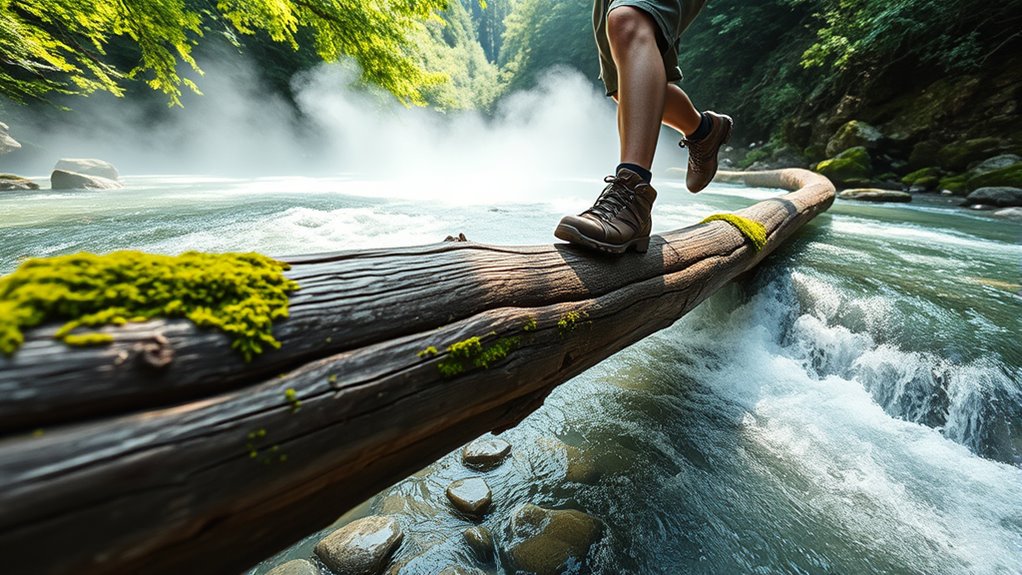When crossing a river, always assess water conditions first—look for calm spots on rocky or sandy ground, avoid visible debris, and watch for strong currents. Wear sturdy, waterproof shoes and use sticks to test depth. Keep your body low, maintain three points of contact, and move slowly. Stay alert for changing weather or upstream rain, and don’t hesitate to turn back if conditions worsen. For more essential tips, continue exploring how to cross rivers safely.
Key Takeaways
- Carefully assess river conditions and identify calm, stable entry points before crossing.
- Use sturdy footwear and trekking poles to maintain balance on wet, uneven surfaces.
- Keep a low stance and maintain three points of contact for stability during crossing.
- Cross slowly and deliberately, coordinating with a partner if possible, to prevent slips and falls.
- Monitor weather and water levels continuously, and be ready to turn back if conditions worsen.

Crossing a river can be dangerous if you don’t take proper precautions, so knowing how to do it safely is vital. Before you even step into the water, assess the situation carefully. Look for the best entry point—preferably where the riverbed is rocky or sandy, as these surfaces provide better footing. Avoid areas with visible currents, debris, or fallen trees, which could indicate stronger flow or hidden hazards. Take a moment to observe the water for a few minutes; watch how it moves and see if there are calmer sections that might be safer to cross. Remember, rushing into a river without understanding its behavior can lead to accidents.
Assess river conditions carefully; choose rocky or sandy entry points and avoid areas with strong currents or debris for safety.
When you’re ready to proceed, consider your footwear. Sturdy, waterproof shoes with good grip will help you maintain stability as you wade through the water. If you have a walking stick or trekking pole, use it to test the depth and stability of the riverbed ahead of you. Keep your body low to the water to improve your balance and reduce the risk of falling. Maintain three points of contact with the ground—two feet and one hand or one foot and two hands—so you stay stable as you cross. Take slow, deliberate steps, and avoid sudden movements that could throw you off balance or dislodge loose footing.
It’s vital to keep your backpack or gear secured and close to your body. If you’re carrying heavy equipment, consider removing unnecessary items that could weigh you down or shift your balance. If you have a partner with you, coordinate your movements. Cross together, helping each other stabilize and sharing the load. If you’re alone, take your time and proceed cautiously, continuously testing the ground ahead. Don’t rush your crossing—hurrying increases the chance of slipping or falling.
Always be prepared to turn back if conditions worsen. Stronger currents, rising water levels, or unseen obstacles can turn a safe crossing into a disaster. Keep an eye on the weather forecast and be mindful of recent rainfall upstream, which can cause sudden increases in water flow. After crossing, dry your feet thoroughly and check for any injuries or cuts that might have occurred during the crossing. Remember, patience and vigilance are your best tools for crossing rivers safely. No matter how experienced you are, respecting the river’s power and taking your time guarantees your safety and helps you avoid unnecessary risks. Understanding the terrain and water conditions can make all the difference in a safe crossing.
Frequently Asked Questions
What Should I Do if My Vehicle Stalls in a River?
If your vehicle stalls in a river, stay calm and avoid trying to restart the engine. Exit the vehicle quickly through the windows if possible, or open the door carefully. Call for help immediately and move to higher ground if you can. Don’t attempt to walk through moving water, as it can be dangerous. Prioritize your safety, and wait for professional assistance to handle the situation.
How Can I Identify the Safest Crossing Point?
Ever wonder how to find the safest river crossing? You should look for a wide, shallow spot with a gentle current. Avoid areas with visible obstacles, debris, or deep pools. Check the water’s clarity and flow by testing it with a stick or stepping in cautiously. Always observe upstream and downstream for hazards, and choose a spot where the bank is stable. Would you risk crossing without these precautions?
What Equipment Is Essential for Crossing Rivers?
You need a sturdy, well-fitting life jacket to stay afloat and a reliable rope to secure yourself or assist others. A waterproof map or GPS helps you find safe crossing points. Also, carry a whistle for signaling, a knife for emergencies, and waterproof footwear for traction. Having these essentials guarantees you’re prepared, reduces risks, and increases your chances of crossing safely.
Are There Specific Signs Indicating Dangerous River Crossings?
Ever wonder if signs warn you about dangerous river crossings? Yes, there are often signs indicating risks like swift currents, deep water, or unstable banks. Look for warning signs, barricades, or colored markers along the riverbank. Do you see flashing lights or reflective strips? These signals help alert you to hazards. Always pay close attention to posted notices and don’t ignore warning signs—they’re vital for your safety.
How Do Weather Changes Affect River Crossing Safety?
Weather changes can drastically impact river crossing safety. Heavy rain, for instance, can cause water levels to rise quickly, creating strong currents and increasing the risk of being swept away. Sudden storms can also reduce visibility and make footing slippery, making crossings more dangerous. Always check weather forecasts before crossing, wait for conditions to improve, and be prepared to turn back if the weather worsens to stay safe.
Conclusion
Remember, crossing a river is like walking a tightrope over rushing waters—you need balance, patience, and awareness. Trust your judgment, prepare properly, and never rush into the current. With the right precautions, you’ll navigate safely across, emerging stronger on the other side. So, stay alert, be cautious, and treat each crossing as a journey, not a gamble—because the river’s secrets aren’t revealed until you respect its power. Stay safe and confident with every step.










